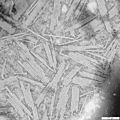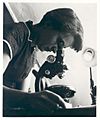Rosalind Franklin facts for kids
Quick facts for kids
Rosalind Elsie Franklin
|
|
|---|---|
 |
|
| Born |
Rosalind Elsie Franklin
25 July 1920 Notting Hill, London, England, UK
|
| Died | 16 April 1958 (aged 37) Chelsea, London, England, UK
|
| Resting place | Willesden United Synagogue Cemetery |
| Nationality | English |
| Education | St Paul's Girls' School |
| Alma mater | University of Cambridge (PhD) |
| Known for |
|
| Scientific career | |
| Fields | |
| Institutions |
|
| Thesis | The physical chemistry of solid organic colloids with special reference to coal (1945) |
| Doctoral students | John Finch and Kenneth Holmes |
Rosalind Franklin (born in Notting Hill, London, on 25 July 1920 – died in London on 16 April 1958) was a British biophysicist. She is famous for her important work on the structure of DNA.
She also studied coal, RNA, and viruses. Rosalind Franklin was one of the first scientists to use X-ray crystallography to study DNA. Her work, along with her student Raymond Gosling, helped Watson and Crick discover the structure of DNA.
Later, Franklin led important research on the structures of viruses at Birkbeck College. She passed away from ovarian cancer at age 37 in 1958. Her team member, Aaron Klug, continued her research and won a Nobel Prize in 1982.
Contents
Early Life and Family
Rosalind Franklin was born in London into a wealthy and influential British Jewish family. Her father, Ellis Arthur Franklin, was a merchant banker. He also taught at the Working Men's College. Her mother was Muriel Frances Waley.
Rosalind was the second of five children. She had an older brother, David, and three younger siblings: Colin, Roland, and Jenifer. Her family was very involved with the Working Men's College. Her father taught subjects like electricity and history there.
Franklin's parents also helped Jewish refugees from Europe. Many of these refugees were escaping the Nazis. They even welcomed two Jewish children into their home.
Education
From a young age, Rosalind was a very smart student. At six, she went to Norland Place School in West London. Her aunt once said Rosalind was "alarmingly clever." She loved doing arithmetic for fun.
When she was nine, she went to a boarding school called Lindores School. At 11, she attended St Paul's Girls' School in London. This was one of the few girls' schools that taught physics and chemistry.
Rosalind was excellent in science, Latin, and sports. She also learned German and became fluent in French. She often topped her classes and won awards. In 1938, she earned a scholarship for university. Her father asked her to give the scholarship money to a refugee student who needed it.
University Studies
In 1938, Franklin went to Newnham College, Cambridge. She studied chemistry there. She finished her final exams in 1941. At that time, women were not given full degrees from Cambridge.
However, Rosalind Franklin later earned her PhD from Cambridge University in 1945.
Work on Coal
During World War II, Franklin wanted to help. From 1942, she worked at the British Coal Utilisation Research Association. She studied how porous, or full of tiny holes, coal was.
Her research helped lead to the idea of strong carbon fibers. This work also formed the basis for her doctoral degree. She earned this degree in 1945.
Work in Paris
After the war, Franklin moved to Paris. She worked with Jacques Mering for three years. There, she learned X-ray diffraction techniques. This method uses X-rays to study the structure of materials.
She was very happy in Paris. Her published research on coal structure made her known internationally. In 1950, she decided to look for work in England. She was offered a job at King's College London.
King's College London
In January 1951, Franklin started at King's College London. She worked in the Biophysics Unit. Her original plan was to study proteins. But her work quickly changed to focus on DNA fibers.
Franklin and her student Raymond Gosling used X-ray diffraction on DNA. They found that DNA had two forms. When wet, DNA was long and thin (called DNA 'B'). When dry, it was short and fat (called DNA 'A'). Franklin focused on studying the 'A' form.
The X-ray pictures Franklin took were very clear and beautiful. By late 1951, scientists at King's believed DNA 'B' was a helix (a spiral shape). But Franklin was not sure if DNA 'A' was also helical.
In 1952, Franklin and Gosling worked hard to understand their X-ray pictures. They used a complex method called the Patterson function. This helped them learn more about the molecule's structure.
In February 1953, Francis Crick and James D. Watson at Cambridge University began building a model of DNA 'B'. They used similar data to what Franklin had. Franklin believed in understanding the structure fully before building models.
Crick and Watson later got access to Franklin's DNA X-ray data, including her famous Photo 51. This data gave them important clues about DNA's structure.
On 25 April 1953, Francis Crick and James Watson published their DNA model in the journal Nature. Their article described the double-helical structure of DNA. Other articles by Wilkins and Franklin in the same issue supported their model. Franklin left King's College London in March 1953. She moved to Birkbeck College.
Birkbeck College, London
At Birkbeck, Franklin used X-ray crystallography to study tobacco mosaic virus (TMV). Her work was supported by the Agricultural Research Council. In 1954, she began working with Aaron Klug. This partnership was very successful.
In 1955, Franklin published a paper in Nature. It showed that TMV virus particles were all the same length. This went against what some other scientists believed, but Franklin's findings were correct.
Franklin led a team studying viruses. She worked on rod-shaped viruses like TMV with her student Kenneth Holmes. Aaron Klug worked on spherical viruses. By the end of 1955, her team had a model of TMV. They also studied viruses affecting other plants. Franklin and Don Casper showed that the RNA in TMV is coiled inside the hollow virus.
Death
In mid-1956, Rosalind Franklin started feeling unwell during a trip to the United States. She found her stomach was bulging. An operation in September revealed two tumors.
After this, Franklin had more hospital stays. She spent time recovering with friends and family. Even while getting cancer treatment, Franklin kept working. Her team published many papers in 1956 and 1957.
Franklin returned to work in January 1958. She was promoted in February. She became ill again in March and passed away on 16 April 1958 in Chelsea, London. She died from bronchopneumonia and ovarian cancer. Some believe her exposure to X-ray radiation might have contributed to her illness.
She was buried on 17 April 1958 in the family plot at Willesden United Synagogue Cemetery.
Personal Life
Rosalind Franklin was described as an agnostic. This means she did not believe in God. She developed this view from a young age.
However, she still respected Jewish traditions. She was the only Jewish student at Lindores School and had Hebrew lessons. She joined the Jewish Society at Cambridge to honor her grandfather. She once told her sister she was "always consciously a Jew."
Franklin loved to travel, especially trekking. She kept her personal feelings private. She never married and did not have children.
Awards and Honours
Posthumous Recognition
Many places and awards have been named after Rosalind Franklin to honor her work:
- In 1984, St Paul's Girls School opened the Rosalind Franklin Technology Centre.
- In 1992, English Heritage placed a blue plaque on her former home in London.
- King's College London renamed a residence hall and a building after her.
- Newnham College, Cambridge opened a residence and placed a bust of her.
- In 1997, a newly found asteroid was named 9241 Rosfranklin.
- The National Portrait Gallery in London added her portrait.
- The Royal Society created the Rosalind Franklin Award for women in science.
- In 2004, Finch University of Health Sciences changed its name to the Rosalind Franklin University of Medicine and Science.
- In 2013, Google honored her with a doodle.
- In 2019, the European Space Agency (ESA) named its ExoMars rover Rosalind Franklin.
- In 2020, the UK Royal Mint released a 50-pence coin featuring a stylized Photo 51 to mark 100 years since her birth.
- In 2021, a satellite was launched into space named "Rosalind."
- In 2022, a new bacterial genus, Franklinella, was named in her honor.
Rosalind Franklin Quotes
- "Science and everyday life cannot and should not be separated."
Images for kids
-
Electronmicrograph of Tobacco Mosaic Virus
-
Mural inscription on King's College London's Franklin-Wilkins Building
-
Rue Rosalind Franklin in Luxembourg
-
Rachel (Rosalind) Franklin st. in Israel
See also
 In Spanish: Rosalind Franklin para niños
In Spanish: Rosalind Franklin para niños









